Observation and Modeling of the Equilibrium Slope Response of a High-Energy Meso-Macrotidal Sandy Beach
Abstract
1. Introduction
2. Study Site and Data
2.1. Truc Vert Beach
2.2. Beach Slope Data
2.3. Wave Data
3. Equilibrium Profile Model
3.1. Equilibrium Model
3.2. Model Parameter Optimization
4. Results
4.1. Beach Profile Change in Time and Space
4.2. Equilibrium Beach Slope Response
5. Discussion
6. Conclusions
Author Contributions
Funding
Institutional Review Board Statement
Informed Consent Statement
Data Availability Statement
Acknowledgments
Conflicts of Interest
References
- Luijendijk, A.; Hagenaars, G.; Ranasinghe, R.; Baart, F.; Donchyts, G.; Aarninkhof, S. The State of the World’s Beaches. Sci. Rep. 2018, 8, 6641. [Google Scholar] [CrossRef] [PubMed]
- Nunes, P.A.L.D.; Ghermandi, A. The Economics of Marine Ecosystems: Reconciling Use and Conservation of Coastal and Marine Systems and the Underlying Natural Capital. Environ. Resour. Econ. 2013, 56, 459–465. [Google Scholar] [CrossRef]
- Poumadère, M.; Bertoldo, R.; Idier, D.; Mallet, C.; Oliveros, C.; Robin, M. Coastal Vulnerabilities under the Deliberation of Stakeholders: The Case of Two French Sandy Beaches. Ocean Coast. Manag. 2015, 105, 166–176. [Google Scholar] [CrossRef]
- Vousdoukas, M.I.; Ranasinghe, R.; Mentaschi, L.; Plomaritis, T.A.; Athanasiou, P.; Luijendijk, A.; Feyen, L. Sandy Coastlines under Threat of Erosion. Nat. Clim. Chang. 2020, 10, 260–263. [Google Scholar] [CrossRef]
- Cooper, J.A.G.; Masselink, G.; Coco, G.; Short, A.D.; Castelle, B.; Rogers, K.; Anthony, E.; Green, A.N.; Kelley, J.T.; Pilkey, O.H.; et al. Sandy Beaches Can Survive Sea-Level Rise. Nat. Clim. Chang. 2020, 10, 993–995. [Google Scholar] [CrossRef]
- Galvin, C.J., Jr. Breaker Type Classification on Three Laboratory Beaches. J. Geophys. Res. 1896-1977 1968, 73, 3651–3659. [Google Scholar] [CrossRef]
- Iribarren Cavanilles, R.; Casto Nogales, M. Protection Des Ports. In Proceedings of the XVIIth International Naval Congress, Lisbon, Portugal, 1 January 1949. [Google Scholar]
- Battjes, J.A. Surf Similarity. Coast. Eng. Proc. 2015, 26, 466–480. [Google Scholar] [CrossRef]
- Castelle, B.; Scott, T.; Brander, R.; McCarroll, J.; Robinet, A.; Tellier, E.; de Korte, E.; Simonnet, B.; Salmi, L.-R. Environmental Controls on Surf Zone Injuries on High-Energy Beaches. Nat. Hazards Earth Syst. Sci. 2019, 19, 2183–2205. [Google Scholar] [CrossRef]
- Robles, L.A. Cervical Spine Injuries in Ocean Bathers: Wave-Related Accidents. Neurosurgery 2006, 58, 920–923, discussion 920–923. [Google Scholar] [CrossRef]
- Puleo, J.A.; Hutschenreuter, K.; Cowan, P.; Carey, W.; Arford-Granholm, M.; McKenna, K.K. Delaware Surf Zone Injuries and Associated Environmental Conditions. Nat. Hazards 2016, 81, 845–867. [Google Scholar] [CrossRef]
- Battjes, J.A.; Bakkenes, H.J.; Janssen, T.T.; van Dongeren, A.R. Shoaling of Subharmonic Gravity Waves. J. Geophys. Res. Oceans 2004, 109, C02009. [Google Scholar] [CrossRef]
- Stockdon, H.F.; Holman, R.A.; Howd, P.A.; Sallenger, A.H. Empirical Parameterization of Setup, Swash, and Runup. Coast. Eng. 2006, 53, 573–588. [Google Scholar] [CrossRef]
- Kamphuis, J.W. Alongshore Sediment Transport Rate. J. Waterw. Port Coast. Ocean Eng. 1991, 117, 624–640. [Google Scholar] [CrossRef]
- Wright, L.D.; Short, A.D. Morphodynamic Variability of Surf Zones and Beaches: A Synthesis. Mar. Geol. 1984, 56, 93–118. [Google Scholar] [CrossRef]
- Short, A. Three Dimensional Beach-Stage Model. J. Geol. 1979, 87, 553–571. [Google Scholar] [CrossRef]
- Wright, L.D.; Chappell, J.; Thom, B.G.; Bradshaw, M.P.; Cowell, P. Morphodynamics of Reflective and Dissipative Beach and Inshore Systems: Southeastern Australia. Mar. Geol. 1979, 32, 105–140. [Google Scholar] [CrossRef]
- Castelle, B.; Masselink, G. Morphodynamics of Wave-Dominated Beaches. Camb. Prisms Coast. Futur. 2023, 1, e1. [Google Scholar] [CrossRef]
- Dionne, J.-C.; Komar, P.D. (1976): Beach Processes and Sedimentation, Englewood Cliffs (New Jersey), Prentice-Hall, xii et 429 p., 218 fig., 18.5 × 24 cm, $33.30. Géogr. Phys. Quat. 1978, 32, 178–179. [Google Scholar] [CrossRef]
- Prodger, S.; Russell, P.; Davidson, M.; Miles, J. Beach Morphological Predictions: The Impact of a Temporally Varying Sediment Fall Velocity. J. Coast. Res. 2016, 75, 447–451. [Google Scholar] [CrossRef]
- Yates, M.L.; Guza, R.T.; O’Reilly, W.C. Equilibrium Shoreline Response: Observations and Modeling. J. Geophys. Res. 2009, 114, C09014. [Google Scholar] [CrossRef]
- Castelle, B.; Marieu, V.; Bujan, S.; Ferreira, S.; Parisot, J.-P.; Capo, S.; Sénéchal, N.; Chouzenoux, T. Equilibrium Shoreline Modelling of a High-Energy Meso-Macrotidal Multiple-Barred Beach. Mar. Geol. 2014, 347, 85–94. [Google Scholar] [CrossRef]
- Splinter, K.D.; Turner, I.L.; Davidson, M.A.; Barnard, P.; Castelle, B.; Oltman-Shay, J. A Generalized Equilibrium Model for Predicting Daily to Interannual Shoreline Response. J. Geophys. Res. Earth Surf. 2014, 119, 1936–1958. [Google Scholar] [CrossRef]
- Lemos, C.; Floc’h, F.; Yates, M.; Le Dantec, N.; Marieu, V.; Hamon, K.; Cuq, V.; Suanez, S.; Delacourt, C. Equilibrium Modeling of the Beach Profile on a Macrotidal Embayed Low Tide Terrace Beach. Ocean Dyn. 2018, 68, 1207–1220. [Google Scholar] [CrossRef]
- Hunt, E.; Davidson, M.; Steele, E.C.C.; Amies, J.D.; Scott, T.; Russell, P. Shoreline Modelling on Timescales of Days to Decades. Camb. Prisms Coast. Futur. 2023, 1, e17. [Google Scholar] [CrossRef]
- Splinter, K.D.; Turner, I.L.; Reinhardt, M.; Ruessink, G. Rapid Adjustment of Shoreline Behavior to Changing Seasonality of Storms: Observations and Modelling at an Open-Coast Beach. Earth Surf. Process. Landf. 2017, 42, 1186–1194. [Google Scholar] [CrossRef]
- Ibaceta, R.; Splinter, K.D.; Harley, M.D.; Turner, I.L. Improving Multi-Decadal Coastal Shoreline Change Predictions by Including Model Parameter Non-Stationarity. Front. Mar. Sci. 2022, 9, 1012041. [Google Scholar] [CrossRef]
- D’Anna, M.; Idier, D.; Castelle, B.; Vitousek, S.; Le Cozannet, G. Reinterpreting the Bruun Rule in the Context of Equilibrium Shoreline Models. J. Mar. Sci. Eng. 2021, 9, 974. [Google Scholar] [CrossRef]
- D’Anna, M.; Idier, D.; Castelle, B.; Rohmer, J.; Cagigal, L.; Mendez, F.J. Effects of Stochastic Wave Forcing on Probabilistic Equilibrium Shoreline Response across the 21st Century Including Sea-Level Rise. Coast. Eng. 2022, 175, 104149. [Google Scholar] [CrossRef]
- Montaño, J.; Coco, G.; Antolínez, J.A.A.; Beuzen, T.; Bryan, K.R.; Cagigal, L.; Castelle, B.; Davidson, M.A.; Goldstein, E.B.; Ibaceta, R.; et al. Blind Testing of Shoreline Evolution Models. Sci. Rep. 2020, 10, 2137. [Google Scholar] [CrossRef]
- Plant, N.G.; Holman, R.A.; Freilich, M.H.; Birkemeier, W.A. A Simple Model for Interannual Sandbar Behavior. J. Geophys. Res. Oceans 1999, 104, 15755–15776. [Google Scholar] [CrossRef]
- Turki, I.; Medina, R.; Coco, G.; Gonzalez, M. An Equilibrium Model to Predict Shoreline Rotation of Pocket Beaches. Mar. Geol. 2013, 346, 220–232. [Google Scholar] [CrossRef]
- Larson, M. Equilibrium Profile of a Beach with Varying Grain Size; ASCE: Reston, VA, USA, 1991; pp. 905–919. [Google Scholar]
- Prodger, S.; Russell, P.; Davidson, M.; Miles, J.; Scott, T. Understanding and Predicting the Temporal Variability of Sediment Grain Size Characteristics on High-Energy Beaches. Mar. Geol. 2016, 376, 109–117. [Google Scholar] [CrossRef]
- Senechal, N.; Abadie, S.; Gallagher, E.; MacMahan, J.; Masselink, G.; Michallet, H.; Reniers, A.; Ruessink, G.; Russell, P.; Sous, D.; et al. The ECORS-Truc Vert’08 Nearshore Field Experiment: Presentation of a Three-Dimensional Morphologic System in a Macro-Tidal Environment during Consecutive Extreme Storm Conditions. Ocean Dyn. 2011, 61, 2073–2098. [Google Scholar] [CrossRef]
- Castelle, B.; Bujan, S.; Marieu, V.; Ferreira, S. 16 Years of Topographic Surveys of Rip-Channelled High-Energy Meso-Macrotidal Sandy Beach. Sci. Data 2020, 7, 410. [Google Scholar] [CrossRef] [PubMed]
- Castelle, B.; Guillot, B.; Marieu, V.; Chaumillon, E.; Hanquiez, V.; Bujan, S.; Poppeschi, C. Spatial and Temporal Patterns of Shoreline Change of a 280-Km High-Energy Disrupted Sandy Coast from 1950 to 2014: SW France. Estuar. Coast. Shelf Sci. 2018, 200, 212–223. [Google Scholar] [CrossRef]
- Castelle, B.; Bujan, S.; Ferreira, S.; Dodet, G. Foredune Morphological Changes and Beach Recovery from the Extreme 2013/2014 Winter at a High-Energy Sandy Coast. Mar. Geol. 2017, 385, 41–55. [Google Scholar] [CrossRef]
- Laporte-Fauret, Q.; Castelle, B.; Michalet, R.; Marieu, V.; Bujan, S.; Rosebery, D. Morphological and Ecological Responses of a Managed Coastal Sand Dune to Experimental Notches. Sci. Total Environ. 2021, 782, 146813. [Google Scholar] [CrossRef]
- Gallagher, E.L.; MacMahan, J.; Reniers, A.J.H.M.; Brown, J.; Thornton, E.B. Grain Size Variability on a Rip-Channeled Beach. Mar. Geol. 2011, 287, 43–53. [Google Scholar] [CrossRef]
- Davidson, M.A.; Splinter, K.D.; Turner, I.L. A Simple Equilibrium Model for Predicting Shoreline Change. Coast. Eng. 2013, 73, 191–202. [Google Scholar] [CrossRef]
- Soulsby, R. Dynamics of Marine Sands: A Manual for Practical Applications; Thomas Telford: London, UK, 1997; ISBN 978-0-7277-2584-4. [Google Scholar]
- Bertsimas, D.; Tsitsiklis, J. Simulated Annealing. Stat. Sci. 1993, 8, 10–15. [Google Scholar] [CrossRef]
- Lemos, C.; Floc’H, F.; Yates, M.L.; Dantec, N.L.; Marieu, V.; Hamon, K.; Cuq, V.; Suanez, S.S.; Delacourt, C. Equilibrium Modeling of the Beach Profile on a Macrotidal Embayed Beach. Coast. Dyn. 2017, 2017, 760–771. [Google Scholar]
- Jackson, D.W.T.; Cooper, J.A.G.; del Rio, L. Geological Control of Beach Morphodynamic State. Mar. Geol. 2005, 216, 297–314. [Google Scholar] [CrossRef]
- Grasso, F.; Michallet, H.; Barthélemy, E.; Certain, R. Physical Modeling of Intermediate Cross-Shore Beach Morphology: Transients and Equilibrium States. J. Geophys. Res. Oceans 2009, 114, C09001. [Google Scholar] [CrossRef]
- Almar, R.; Castelle, B.; Ruessink, G.; Senechal, N.; Bonneton, P.; Marieu, V. High-Frequency Video Observation of a Double Sandbar System under High-Energy Wave Forcing. J. Coast. Res. 2009, 1706–1710. [Google Scholar]
- Jaramillo, C.; Jara, M.S.; González, M.; Medina, R. A Shoreline Evolution Model Considering the Temporal Variability of the Beach Profile Sediment Volume (Sediment Gain/Loss). Coast. Eng. 2020, 156, 103612. [Google Scholar] [CrossRef]
- Dean, R.G. Equilibrium Beach Profiles: Characteristics and Applications. J. Coast. Res. 1991, 7, 53–84. [Google Scholar]
- Vitousek, S.; Cagigal, L.; Montaño, J.; Rueda, A.; Mendez, F.; Coco, G.; Barnard, P.L. The Application of Ensemble Wave Forcing to Quantify Uncertainty of Shoreline Change Predictions. J. Geophys. Res. Earth Surf. 2021, 126, e2019JF005506. [Google Scholar] [CrossRef]
- Splinter, K.D.; Harley, M.D.; Turner, I.L. Remote Sensing Is Changing Our View of the Coast: Insights from 40 Years of Monitoring at Narrabeen-Collaroy, Australia. Remote Sens. 2018, 10, 1744. [Google Scholar] [CrossRef]
- Ludka, B.; Guza, R.; O’reilly, W.; Merrifield, M.; Flick, R.; Bak, S.; Hesser, T.; Bucciarelli, R.; Olfe, C.; Woodward, B.; et al. Sixteen Years of Bathymetry and Waves at San Diego Beaches. Sci. Data 2019, 6, 161. [Google Scholar] [CrossRef]
- Turner, I.; Harley, M.; Short, A.; Simmons, J.; Bracs, M.; Phillips, M.; Splinter, K. A Multi-Decade Dataset of Monthly Beach Profile Surveys and Inshore Wave Forcing at Narrabeen, Australia. Sci. Data 2016, 3, 160024. [Google Scholar] [CrossRef]
- Bertin, S.; Floc’h, F.; Le Dantec, N.; Jaud, M.; Cancouët, R.; Franzetti, M.; Cuq, V.; Prunier, C.; Ammann, J.; Augereau, E.; et al. A Long-Term Dataset of Topography and Nearshore Bathymetry at the Macrotidal Pocket Beach of Porsmilin, France. Sci. Data 2022, 9, 79. [Google Scholar] [CrossRef] [PubMed]
- Dodet, G.; Castelle, B.; Masselink, G.; Scott, T.; Davidson, M.; Floc’h, F.; Jackson, D.; Suanez, S. Beach Recovery from Extreme Storm Activity during the 2013–14 Winter along the Atlantic Coast of Europe. Earth Surf. Process. Landf. 2019, 44, 393–401. [Google Scholar] [CrossRef]
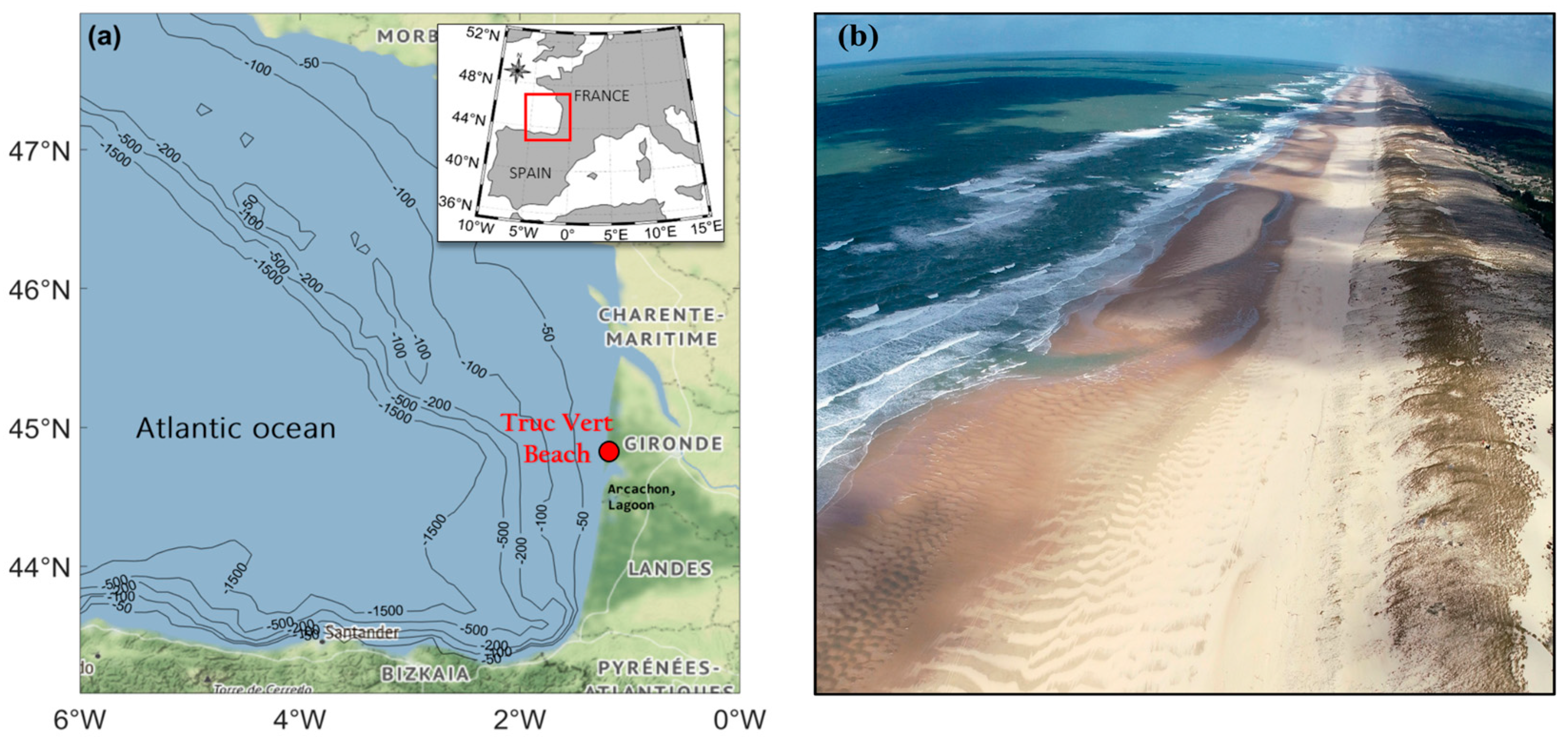
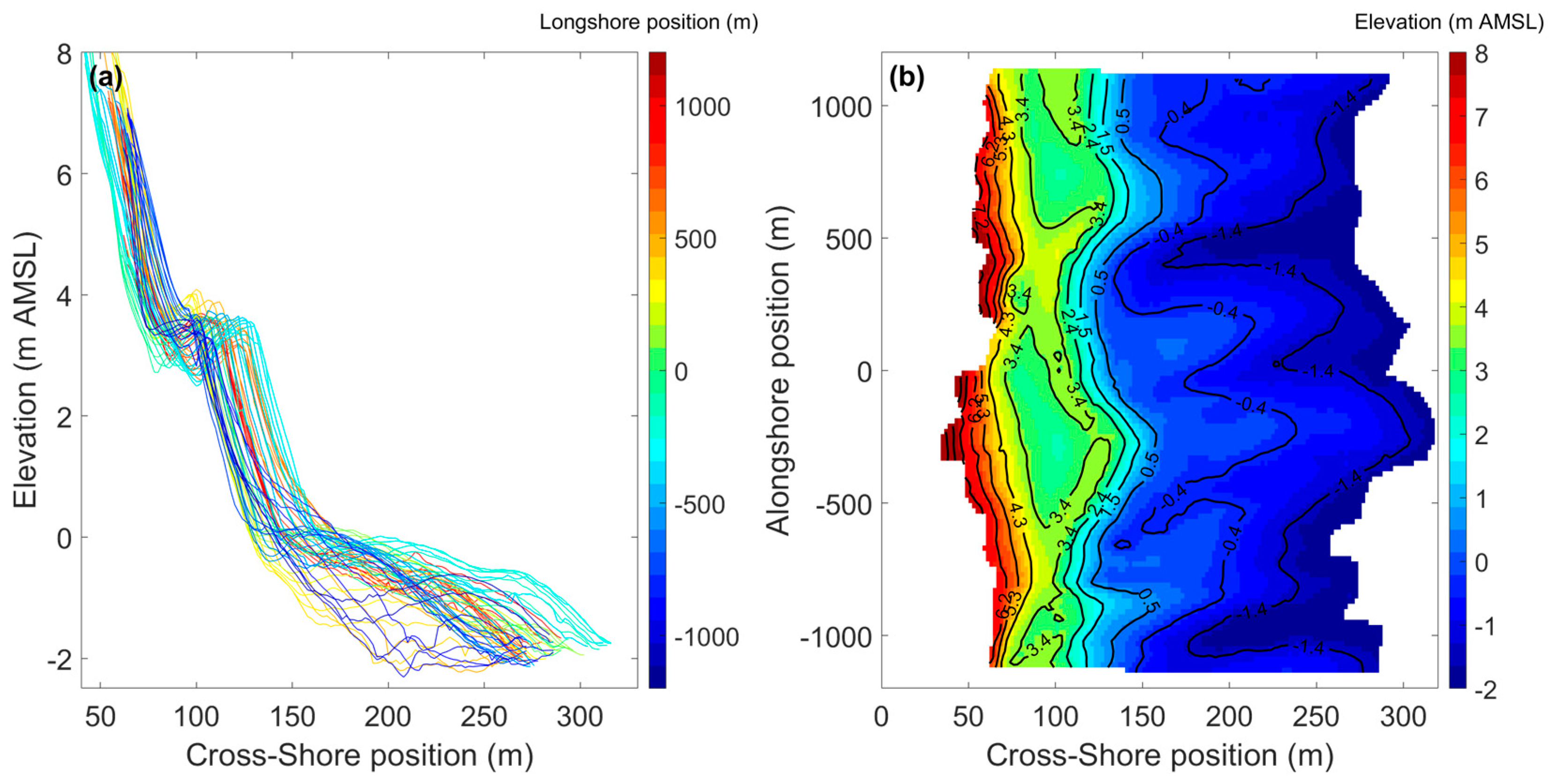

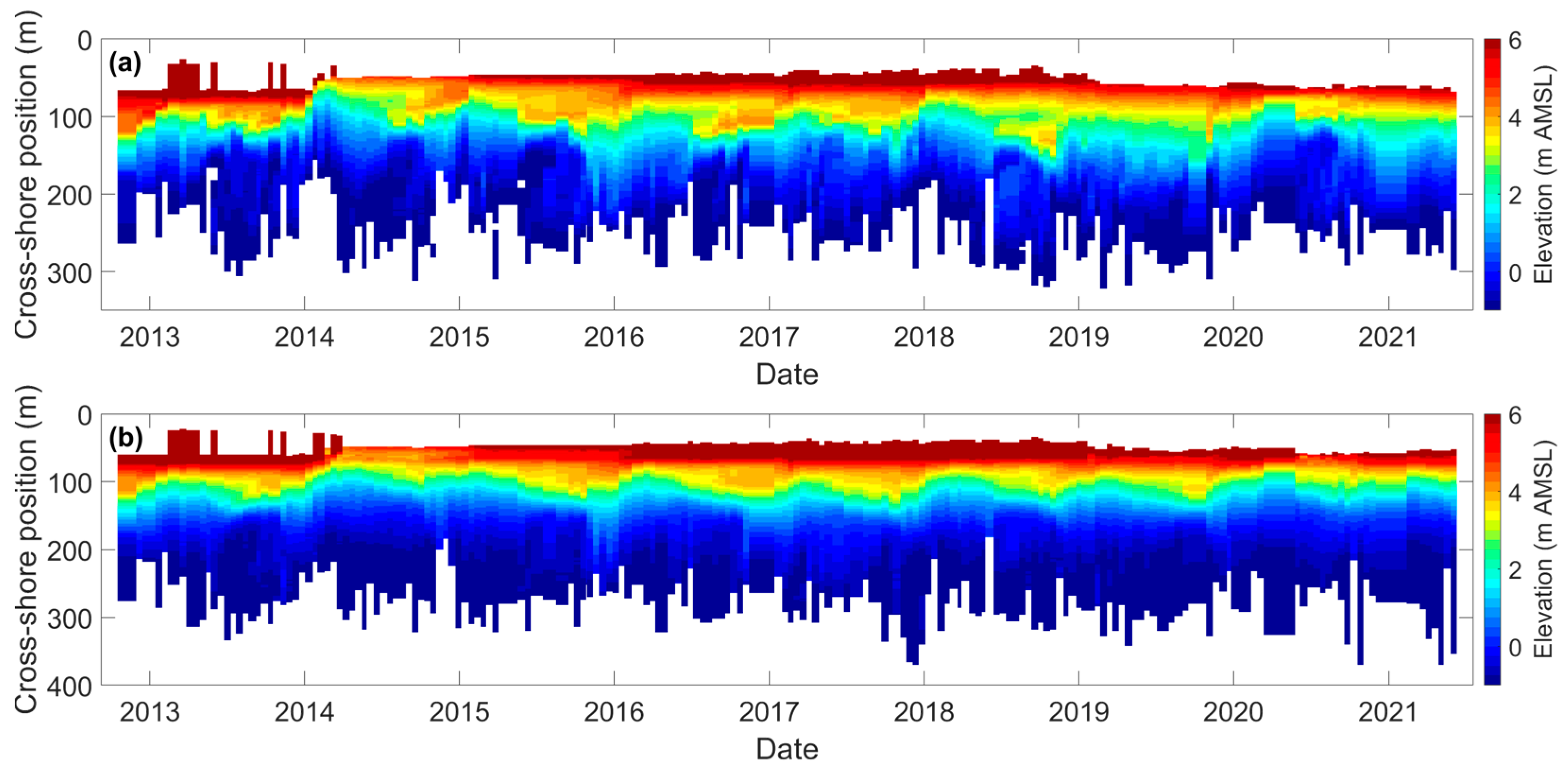
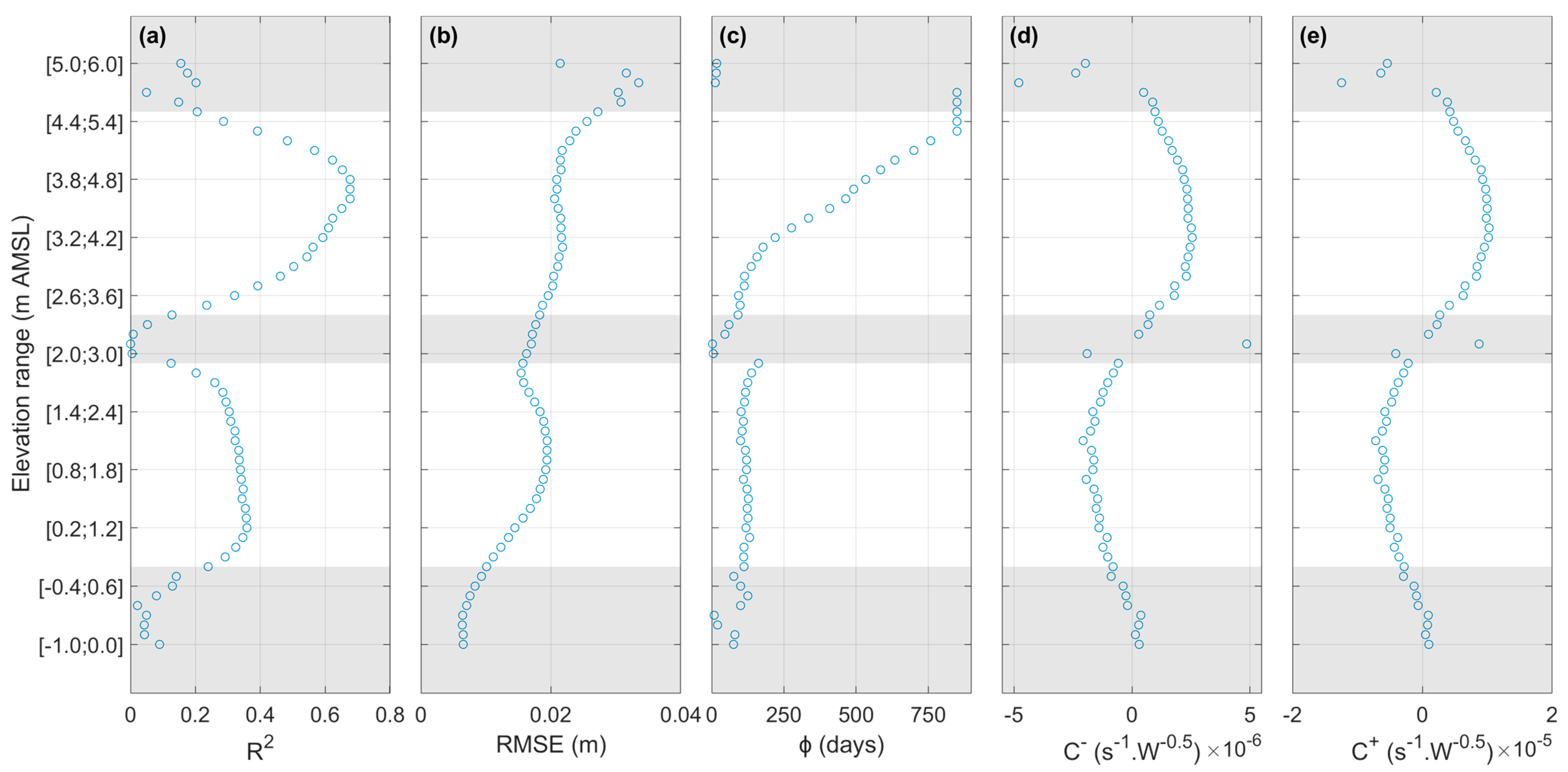
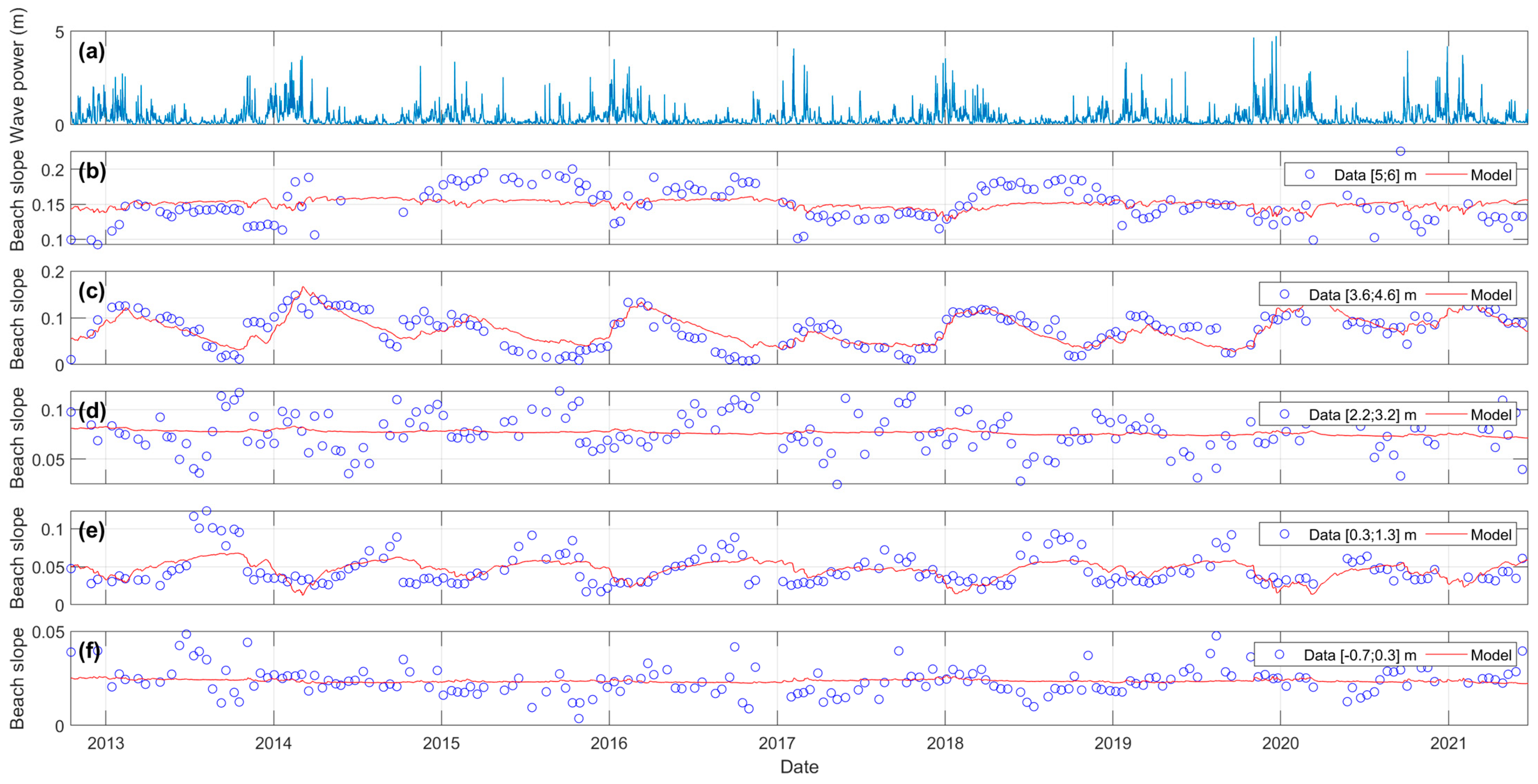
| S0 | Φ | C− | C+ |
|---|---|---|---|
| (m) | (days) | (s−1·W−0.5) | (s−1·W−0.5) |
| [−0.5;0.5] | [1;850] | [−0.000008;0.0000081] | [−0.000025;0.000024] |
Disclaimer/Publisher’s Note: The statements, opinions and data contained in all publications are solely those of the individual author(s) and contributor(s) and not of MDPI and/or the editor(s). MDPI and/or the editor(s) disclaim responsibility for any injury to people or property resulting from any ideas, methods, instructions or products referred to in the content. |
© 2023 by the authors. Licensee MDPI, Basel, Switzerland. This article is an open access article distributed under the terms and conditions of the Creative Commons Attribution (CC BY) license (https://creativecommons.org/licenses/by/4.0/).
Share and Cite
Labarthe, C.; Castelle, B.; Marieu, V.; Garlan, T.; Bujan, S. Observation and Modeling of the Equilibrium Slope Response of a High-Energy Meso-Macrotidal Sandy Beach. J. Mar. Sci. Eng. 2023, 11, 584. https://doi.org/10.3390/jmse11030584
Labarthe C, Castelle B, Marieu V, Garlan T, Bujan S. Observation and Modeling of the Equilibrium Slope Response of a High-Energy Meso-Macrotidal Sandy Beach. Journal of Marine Science and Engineering. 2023; 11(3):584. https://doi.org/10.3390/jmse11030584
Chicago/Turabian StyleLabarthe, Carla, Bruno Castelle, Vincent Marieu, Thierry Garlan, and Stéphane Bujan. 2023. "Observation and Modeling of the Equilibrium Slope Response of a High-Energy Meso-Macrotidal Sandy Beach" Journal of Marine Science and Engineering 11, no. 3: 584. https://doi.org/10.3390/jmse11030584
APA StyleLabarthe, C., Castelle, B., Marieu, V., Garlan, T., & Bujan, S. (2023). Observation and Modeling of the Equilibrium Slope Response of a High-Energy Meso-Macrotidal Sandy Beach. Journal of Marine Science and Engineering, 11(3), 584. https://doi.org/10.3390/jmse11030584






